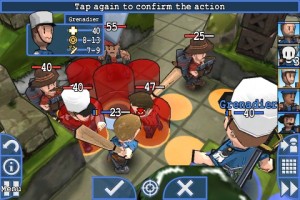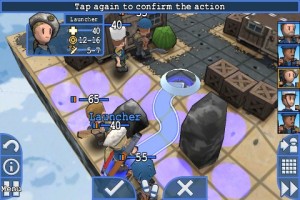(Editor’s Note: What follows is the original review written for the first version the author played. Since then, one or more major critiques have been addressed by the developer. For a list of these, see “Addendums” below the original review score at the end of the article.)
It’s been a long and arduous road for TOME Studios, but Danger Alliance: Battles (Out Now, $1.99 Sale; Lite) has finally airdropped into the App Store! Too bad we don’t get to learn much about DA’s world at this point, because the tongue-in-cheek mission briefings and class descriptions carry a great sense of humor that’s whet my appetite for more in the plot department. For now, it’s best to approach DA precisely as you would most other titles on iOS: a series of levels strung together without much context, and therefore its ability to vie for your attention rides entirely on its gameplay quality and breadth of content. Considering TOME’s tip-of-the-iceberg plan, that last point has no doubt left some TBS fans cautious. As a long-time TBS veteran myself, I must say I am impressed with how well DA makes use of its limited content at release, and how much time I ended up spending with the final product.
 As described in last July’s preview, DA is an isometric Turn-Based Strategy game very much in the Final Fantasy Tactics vein: the player shifts his or her soldiers over a square grid, carefully considering movement ranges and area attack effects. The most important differences between DA and Final Fantasy Tactics are thus: DA makes use of 20th century military technology as opposed to swords & sorcery, and DA has the advantage of being developed specifically for iOS.
As described in last July’s preview, DA is an isometric Turn-Based Strategy game very much in the Final Fantasy Tactics vein: the player shifts his or her soldiers over a square grid, carefully considering movement ranges and area attack effects. The most important differences between DA and Final Fantasy Tactics are thus: DA makes use of 20th century military technology as opposed to swords & sorcery, and DA has the advantage of being developed specifically for iOS.
Rather than intersperse the turns of individual player and enemy characters, DA lets the player move his or her entire squad before turning the field over to enemy AI — or to a human friend via hotseat multiplayer, if TBS fans happen to be plentiful in your neck of the woods. A soldier’s turn includes one movement and one action. Each character is equipped with class-specific long range and melee weaponry; rounding out his or her repertoire are a med kit for healing adjacent allies and the ability to adopt a defensive posture while awaiting enemy attacks. Movement and targeting are accomplished through a slick tap interface; players will surely appreciate how easy it is to pick out individual squares regardless of battlefield zoom level or rotation angle. Tapping again on a selection virtually does away with the need for confirmation buttons, although the developer left these in for good measure.
 A column of portraits lined up along the right touchscreen edge give the impression of a queue at first, but in fact, the player may move his or her characters in any order by tapping on them individually. Character turns can even be interrupted without undoing movements: sometimes it’s useful to check what another character is able to accomplish before deciding where the first character’s shot should land. Naturally, movements can also be undone by way of a “back” button if the player catches a strategic error. Genre fans will appreciate the flexibility this all brings to the experience compared to TBSs where turns are executed in a strict sequence.
A column of portraits lined up along the right touchscreen edge give the impression of a queue at first, but in fact, the player may move his or her characters in any order by tapping on them individually. Character turns can even be interrupted without undoing movements: sometimes it’s useful to check what another character is able to accomplish before deciding where the first character’s shot should land. Naturally, movements can also be undone by way of a “back” button if the player catches a strategic error. Genre fans will appreciate the flexibility this all brings to the experience compared to TBSs where turns are executed in a strict sequence.
DA offers six character classes at release. As in Squids, each enjoys a unique feel and attack specialty but lacks upgrades or skill trees. Nor is equipment changing on tap quite yet. TOME did an insightful thing in limiting the player’s squad to five soldiers, and allowing the player to take more than one of each class into battle, as this tickles the TBS fan’s inclination to experiment with different team lineups. Also like Squids, DA is backed up by great environment design. Battlefields vary quite a bit in size and structure, and genre fans should definitely appreciate the consideration poured into placement of obstacles that tend to corral inexperienced players or stymie line-of-sight weaponry.
 Having the player gradually unlock battlefields was definitely a wise design choice, as this provides the sense of gameplay progression needed to keep the TBS fan hanging on for now. Six battles are far too few for the price range, but I feel there are really twelve in DA’s entire campaign: once all six are cleared in Elimination mode, a Strategic Victory mode opens that essentially doubles the game’s length. Victory in Elimination mode requires the mere defeat of an opposing squad. The unlocked mode has the player capturing and defending flag-marked areas of the battlefield, holding out against endless waves of enemies until the flags have been successfully guarded for a certain number of turns. Enemy AI can be changed, but even if you’re a diehard TBS veteran, beware: even on Normal, enemies are quite intelligent. Battles easily stretch on for twenty minutes, so the genre fan will spend four to six hours with DA before exhausting all content.
Having the player gradually unlock battlefields was definitely a wise design choice, as this provides the sense of gameplay progression needed to keep the TBS fan hanging on for now. Six battles are far too few for the price range, but I feel there are really twelve in DA’s entire campaign: once all six are cleared in Elimination mode, a Strategic Victory mode opens that essentially doubles the game’s length. Victory in Elimination mode requires the mere defeat of an opposing squad. The unlocked mode has the player capturing and defending flag-marked areas of the battlefield, holding out against endless waves of enemies until the flags have been successfully guarded for a certain number of turns. Enemy AI can be changed, but even if you’re a diehard TBS veteran, beware: even on Normal, enemies are quite intelligent. Battles easily stretch on for twenty minutes, so the genre fan will spend four to six hours with DA before exhausting all content.
All things considered, then, I feel DA barely squeaks by the breadth of content minimum needed to justify its normal price tier. The promised updates – online multiplayer, a bona fide story campaign, more soldier classes – would be sweet icing on the cake, but what’s already here is entertaining enough that it isn’t only a faith purchase for genre fans. Its greatest weakness lies instead in stability issues, at least on the iPod Touch 4. Enemy AI execution doesn’t appear to be optimized on the smaller iDevices, requiring an uncomfortably long time before adversaries finally get off their duffs and bring the pain. Sadly, a highly reproducible bug also snuck into the release version, crashing the game during the transition from one battle to the next. (Reviewer’s note: the developer has since discovered this is specific to the iPod Touch 4 and is working on a solution) DA’s auto-save system saves the day and prevents any progress from being lost, but it’s still a nuisance that cuts into the game’s appeal at release. User video confirms that enemy AI processing goes quite a bit faster on the iPad 2, so this may bode well for the game’s overall performance on the larger iDevice.
DA’s cel-shaded character models and environments are just lovely. Brendon Kirk’s title track did set me up for disappointment, however — after an opening flourish that good I was hoping for epic music throughout, but battles play to the backdrop of sound effects only.
iFanzine Verdict: Danger Alliance: Battles clearly illustrates the potential of the Turn-Based Strategy genre on iOS, proving that strategic depth can go hand in hand with a rock solid interface. Those concerned about the content-to-price ratio may very well be surprised by how long this one keeps their attention, thanks to skillful use of its limited assets. On the downside, stability issues still have to be addressed before it becomes a must-have for genre fans equipped only with the iPhone or iPod Touch. If you’re running one of the smaller iDevices, best give the Lite a download first and see how it handles.
Addendum: Crash issue fixed on iPod Touch 4
Addendum: New enemy and weapon type introduced


